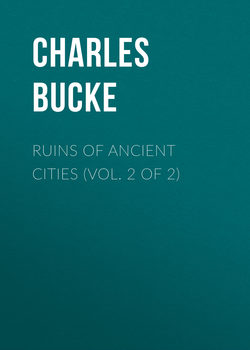Ruins of Ancient Cities (Vol. 2 of 2)

Реклама. ООО «ЛитРес», ИНН: 7719571260.
Оглавление
Charles Bucke. Ruins of Ancient Cities (Vol. 2 of 2)
NO. I. – MESSENE
NO. II. – MYCENÆ
NO. III. – MILETUS
NO. IV. – NAUPLIA
NO. V. – NEMEA
NO. VI. – NINEVEH
NO. VII. – NUMANTIA
NO. VIII. – OLYMPIA
NO. IX. – PUTEOLI
NO. X. – PALMYRA. (TADMOR.)
NO. XI. – PATRÆ
NO. XII. – PELLA
NO. XIII. – PERGAMUS
NO. XIV. – PERSEPOLIS
NO. XV. – PETRA (WADY MOUSA)
NO. XVI. – PHIGALIA
NO. XVII. – PLATÆA
NO. XVIII. – PÆSTUM.101
NO. XIX. – POMPEII
NO. XX. – RAMA
NO. XXI. – ROME
NO. XXII. – SAGUNTUM
NO. XXIII. – SAIS
NO. XXIV. – SAMARIA
NO. XXV. – SAPPHURA
NO. XXVI. – SARDIS
NO. XXVII. – SELEUCIA
NO. XXVIII. – SELINUS, OR SELINUNTUM
NO. XXIX. – SICYON
NO. XXX. – SIDON
NO. XXXI. – SMYRNA
NO. XXXII. – SPALATRO
NO. XXXIII. – STRATONICE
NO. XXXIV. – SUSA
NO. XXXV. – SYBARIS
NO. XXXVI. – SYENE
NO. XXXVII. – SYRACUSE
NO. XXXVIII. – THEBES
NO. XXXIX. – TROJA, AND OTHER CITIES OF THE TROAS
NO. XL. – TYRE
NO. XLI. – VEII
Отрывок из книги
This city was the capital of Agamemnon, who was the commander-in-chief of the assembled Greeks, before the walls of Troy. This event took place, B. C. 1184; and the present ruins are supposed to be the ruins of the city before that event.
Perseus translated the seat of his kingdom from Argos to Mycenæ. The kings who reigned at Mycenæ, after Perseus, were Erectryon, Sthenelus, and Eurystheus. The last, after the death of Hercules, declared open war against his descendants, apprehending they might some time or other attempt to dethrone him; which, as it happened, was done by the Heraclidæ; for, having killed Eurystheus in battle, they entered victorious into Peloponnesus; and made themselves masters of the country. But a plague obliged them to quit the country. Three years after this, being deceived by the ambiguous expression of the oracle, they made a second attempt, which likewise proved fruitless. This was about twenty years before the taking of Troy.
.....
The ruins were next visited by Mr. Bruce: – “When we arrived at the top of the hill,” says he, “there opened before us, the most astonishing, stupendous, sight, that perhaps ever appeared to mortal sight. The whole plain below, which was very extensive, was covered so thick with magnificent ruins, as the one seemed to touch the other, all of fine proportions, all of agreeable forms, all composed of white stone, which, at that distance, appeared like marble. At the end of it stood the Palace of the Sun, a building worthy so magnificent a scene.”
The effect on the imagination of Mr. Addison appears to have been equally lively: – “At the end of the sandy plain,” says he, “the eye rests upon the lofty columns of the Temple of the Sun, encompassed by a dark elevated mass of ruined buildings; and beyond, all around, and right and left towards the Euphrates, as far as the eye can reach, extends the vast level naked flat of the great desert, over which the eye runs in every direction, piercing the boundless horizon, without discovering a human being or a trace of man. Naked, solitary, unlimited space extends around, where man never breathes under the shade, or rests his limbs under the cover of a dwelling. A deep blue tint spreads along its surface, here and there shaded with a cast of brown; the distant outline of the horizon is clear and sharply defined; not an eminence rises to break the monotonous flat, and along the edge extends a large district covered with salt, distinguished from the rest by its peculiar colour.
.....